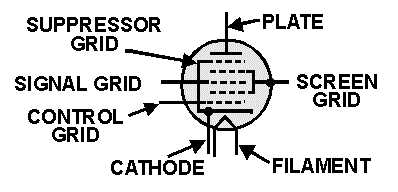2-3
Figure 2-2.—Multi-unit tube Identification.
Another type of special-purpose tube is the MULTI-ELECTRODE tube. In some applications,
tubes require more than the three grids found in conventional tubes. In some cases, up to seven grids may
be used. These types of tubes are called multi-electrode tubes and are normally classified according to the
number of grids they contain. An example of this is illustrated in figure 2-3. Here, you see a tube with
five grids; hence, its name is "pentagrid." The application of these tube types is beyond the scope of this
module, but because multi-electrode tubes have been commonly used you should be aware of their
existence.
Figure 2-3.—Pentagrid multi-electrode tube.
BEAM POWER AND POWER PENTODE TUBES
The tube types you studied in the first chapter have one serious drawback; namely, they are not
suitable as power amplifiers. Because of high-plate resistance and internal construction, tubes such as the
triode, tetrode, and pentode are used only as voltage amplifiers. When power amplification is required
(high-current requirements), special-purpose tubes called POWER PENTODES and BEAM POWER
tubes are used.
Figure 2-4 shows the arrangement of grids in a conventional pentode. The small circles depict cross
sections of the grids. Notice that each grid is offset, or staggered, from the grid directly behind it. This
arrangement of grids permits each grid to be exposed to the electron stream flowing from cathode to plate.



